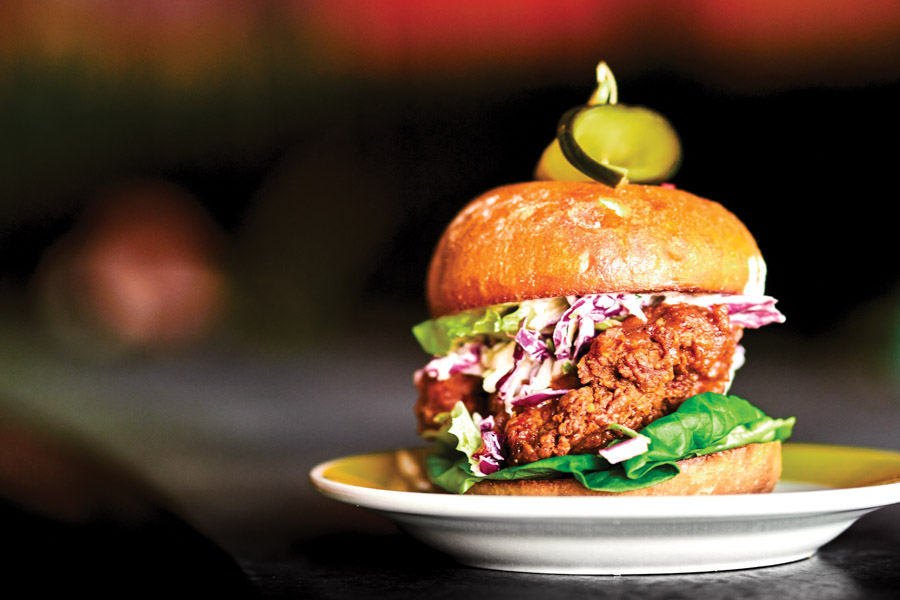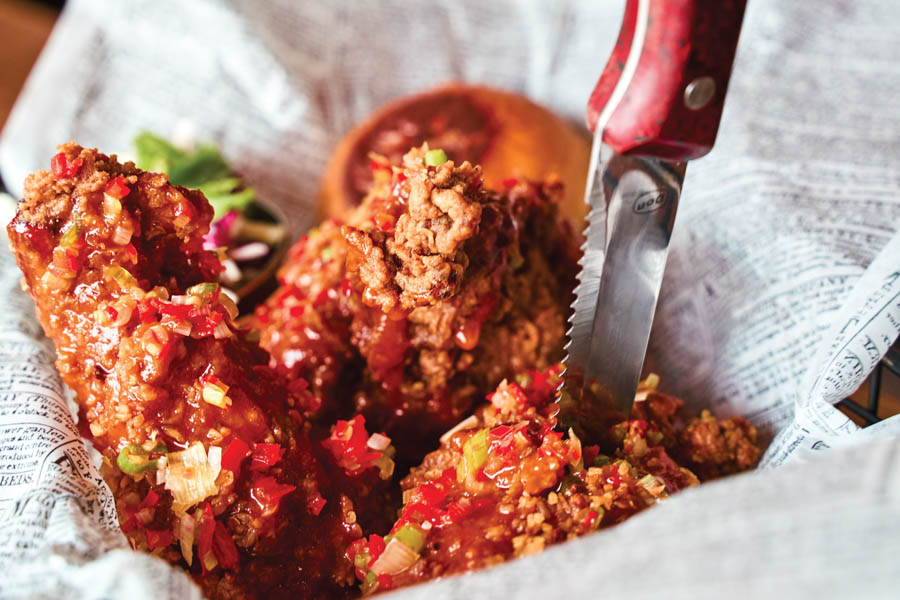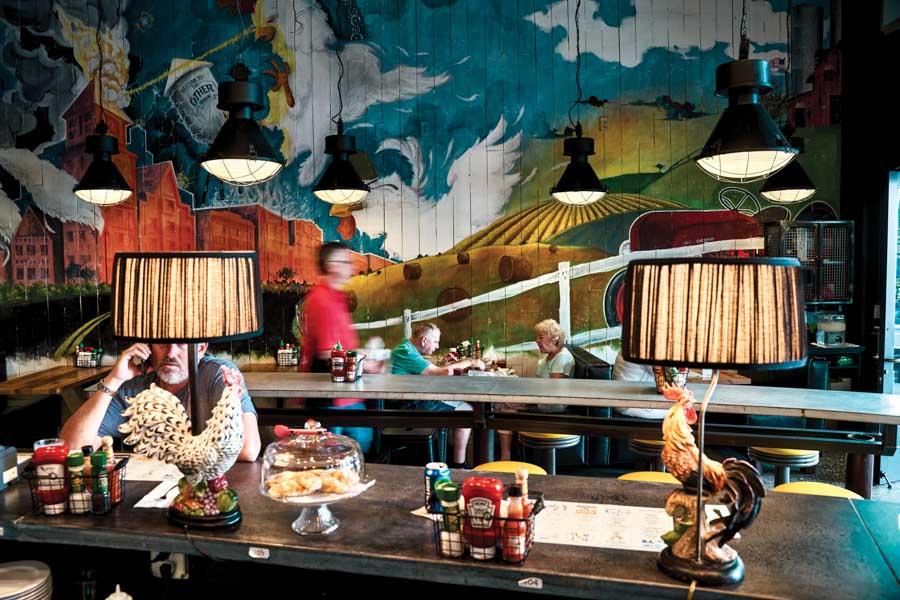It’s a sad and simple fact of the modern menu that fried chicken just doesn’t command the same reverence it once did. In a pre-war world of boiled vegetables and bland meats, the words flashed like a neon beacon in the darkness, a culinary respite on that long, lonesome highway to one’s inevitable Last Supper. It thrived in the Great Depression, coming through with a new champion in the form of a monochromatic Kentucky Colonel. And amongst the irradiated meatloaves of the mid-century microwave craze, it brought a nostalgic authenticity to the dinner table that not even the most sophisticated science oven could hope to replicate. An ode to excess that mirrored the true American spirit, when the 1980s saw the popularization of “too big to fail,” they might as well have been talking about fried chicken.

THE KIM CHEE YUM SANDWICH PAIRS FRIED CHICKEN WITH KIM CHEE SLAW AND KOREAN PICKLE SSAMJUNG RELISH.PHOTOGRAPHY BY WYATT KOSTYGAN.
But alot has changed in 40 years. Salt is bad for the blood pressure, grease clogs the heart and those carbs are making you fat, so they say. All natural, organic, cold-pressed and asbestos-free is in; battered and fried is out. Meat is the enemy and “craft toast” is the new normal. A once-responsible emphasis on healthy living has officially graduated from trend to phase to all-out assault on good taste. And as the calorie counters and cholesterol critics wage war from their temples of tofu, Sarasota restaurateurs Tom Gumpel and Mark Caragiulo make their stand like half-crazed culinary outlaws on the parapets of a breaded and battered Alamo they call The Daily Bird.
Settled into the space freshly abandoned by Atlantic Beer & Oyster, a speedy renovation has transformed the cold and vaguely nautical into something offbeat and welcoming—a strange and irreverent hybrid of down-home and upscale, where a joke-filled menu smacks equally of traditional fare and global inspiration, and a wall mural with Godzilla-sized chickens wreaking havoc with laser-beam-eyes looms over it all.

The menu comes largely from Gumpel, who, after serving 14 years hard time as vice president of product development at Panera Bread, finally gets to let his creative juices flow freely. From the spectacularly spicy Trashville Hot to the delightfully balanced Early Bird (chicken sage sausage, white cheddar, bacon jam and a fried egg) and the Korean-inspired Kim Chee Yum with ssamjang relish, the sandwich selection borders on the unhinged just enough to be wildly creative, while sides like deviled eggs and a central offering of Daily Dirty Poutine remind diners that this is no ordinary “southern-fried” chicken shop. (“We’re New Yorkers,” Gumpel says flatly. “Faking authenticity is the worst.”) But Daily Bird is still a chicken shop, and the defining question for Daily Bird will be the selfsame interrogative that doomed KFC—is the fried chicken actually any good?
“It’s a little bit of an illness,” says Gumpel, self-diagnosing his pursuit of perfect chicken as perhaps something more than healthy. Before making their own, he and Caragiulo sampled fried chicken from around the country, looking for the best—looking for something so good it could possibly dissuade them from the necessity of their endeavor. From Vegas to New York, each leaves him unsatisfied. “I don’t think we found great chicken out there,” he says. “Using culinary fundamentals and a passion for it, we could do better.” He admits to an obvious bit of ego in the statement, but does not apologize. Rather, he explains.

PHOTO BY WYATT KOSTYGAN.
Better fried chicken begins with a better bird, so sayeth the Gospel according to Gumpel, and so the Daily Bird sources its chicken from Springer Mountain, a small chicken farm in Atlanta, GA, where the standards are “higher than organic.” Some birds are raised for speed, hitting maturity in record time, others are raised for egg production and ostensibly still more are raised for all manner of chickenly duties that the peaceful among us will live lives blissfully unaware of. “In the case of Springer Mountain,” says Gumpel, “they’re building the best-tasting bird.” And while 2,500 Panera Breads was too much for the folks at Springer Mountain to handle, for Daily Bird they helped Gumpel and Caragiulo build a whole new supply chain to make it possible.
Once arrived, the birds immediately go under the knife, with Gumpel or one of his acolytes breaking the bird down into two legs, two thighs and four chunks of breast meat. These will be the “bones,” or the bone-in fried chicken. Not yet ready to fry, the bones must be brined for at least a day in a water-based solution of salt, sugar, garlic, cumin and enough Spanish paprika to colonize a small country. After 24 to 28 hours, the water has been forced out of the bones, replaced with so much brine that it keeps the meat pink even after cooking.
From the brine, the bones hit the dredging station, where they’re dipped and dragged through a flour-based dredge with salt, oregano, thyme and even more paprika, then into buttermilk and then once more into the dredge. Once satisfactorily smothered, it’s straight to the pressure fryer. “Inspired by the Colonel,” Gumpel says. “It draws a lot of flavor to the bone and pushes the brine through. It’s just beautiful.”
Served up hot, crispy and with a big knife plunged through the breast like some poultrified Polonius, it’s juicy and flavorful enough to eat naked, but can be tossed with one of three signature sauces, including the Crazy Rich Asian and the aforementioned Trashville Hot. An homage to the famous Nashville Hot, the Sarasota version significantly reduces both the heat level and lard content.
It’s not the only accommodation the menu makes to a more health-conscious lifestyle, cause while Gumpel and Caragiulo may be fried chicken fanatics, they’re no fools—and no business benefits from encouraging coronaries in its customer base. Gumpel proves a secret sprouted grain enthusiast, almost as excited to show off the trays of baby grains as he is those baskets of bones. Wheat, quinoa—the grain changes with the day—but Gumpel coaxes each to a point of just barely sprouting, before harvesting the lot as a bed for the day’s salads. “That’s when grain is at its most nutritious,” he says, before it expends its resources growing into a full sprout. Topped with sliced and feathered grilled chicken, the lean and light fare offers a purposed and flavorful counterpoint to an otherwise unabashedly heavy menu.
Et tu, Gumpel? The senators brought their knives for the chicken, but will this betrayal direct their blades elsewhere? Under a deep-fried veneer of devil-may-care defiance and derring-do, has yet another health food operation full of rabbit food and empty promises arisen unchallenged? Gumpel remains unconcerned, regarding the aberration as evidence of his dedication to flavor over all else, following the tastes but not the trends in the pursuit of something wonderfully simple. He points to the sandwiches, all made with brined and boneless dark thigh meat, sourced from Springer Farms just for that purpose. It’s a risk, he says, but also a statement. “Every other company takes a big slab of breast, puts it on a bun and you’re biting into this big, thick piece of flesh,” he says. “We’re making it better.”








